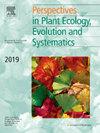Biological flora of Central Europe: Centaurea cyanus L.
IF 2.9
3区 环境科学与生态学
Q1 ECOLOGY
Perspectives in Plant Ecology Evolution and Systematics
Pub Date : 2025-05-14
DOI:10.1016/j.ppees.2025.125874
引用次数: 0
Abstract
Centaurea cyanus L., commonly known as cornflower, is an annual plant of the Asteraceae family, probably native to the Eastern Mediterranean region and historically a common weed of cereal crops. It is placed within the genus Centaurea, although the distinction between the genera Centaurea and Cyanus is controversial. C. cyanus has distinctive blue-violet flowers, erect grey-green stems, and lyrate basal leaves. Although its initial distribution was centred in the Eastern Mediterranean region, C. cyanus has spread to Europe, North America, and Asia as a weed. However, intensive farming practices have caused a significant decline in its populations. It grows in various habitats but most frequently in agricultural habitats with nutrient-rich soils and high light availability. It completes its life cycle between winter and spring, showing two distinct emergence periods: one in autumn and one in spring, depending on environmental conditions. C. cyanus has hermaphroditic flowers that are primarily cross-pollinated but can show pseudo-self-compatibility. The plant is pollinated by various insects including bees (Apis mellifera, Bombus spp.), and hoverflies (Syrphidae), which are attracted to its nectar-rich flowers. Its seeds are dispersed by several agents including wind, ants, and mechanical tillage. Seeds show primary dormancy, with optimal germination temperatures between 10 °C and 15 °C. C. cyanus competes poorly with crops and is susceptible to herbivores and pathogens, which can limit its establishment in agricultural fields. However, its association with mycorrhizal fungi plays a beneficial role in soil remediation, enhancing nutrient uptake and improving soil health. C. cyanus contains many secondary compounds including tocopherols, organic and phenolic acids, and anthocyanins with antioxidant and antibacterial activities. C. cyanus is a species of high ecological and genetic relevance. It displays notable within-population genetic diversity, and substantial differentiation among populations, which underlies its adaptive potential across diverse environments. However, the species still faces threats from climate change, habitat degradation, and agricultural practices. It was used in traditional medicine, and has culinary, cosmetic, and ornamental uses. Its conservation status is currently "Least Concern” at the European and European Union levels, but its fragmented distribution, increased inbreeding, declining population trend due to agricultural intensification, high nitrogen inputs, herbicide use, and decreased pollinator activity warrant attention.
中欧的生物植物区系:半人马。
矢车菊,俗称矢车菊,是菊科一年生植物,可能原产于地中海东部地区,历史上是谷类作物的一种常见杂草。它被置于半人马座属,尽管半人马座属和蓝藻属之间的区别是有争议的。蓝紫色花,直立的灰绿色茎,lyrate基生叶。虽然它最初的分布集中在东地中海地区,但C. cyanus已经作为一种杂草传播到欧洲、北美和亚洲。然而,集约化耕作导致其种群数量显著下降。它生长在各种栖息地,但最常见的是在土壤营养丰富、光照利用率高的农业栖息地。它的生命周期在冬季和春季之间完成,根据环境条件,有两个不同的出现期:一个在秋季,一个在春季。蓝草有雌雄同体的花,主要是异花授粉,但也可以表现出伪自交。这种植物由各种昆虫授粉,包括蜜蜂(Apis mellifera, Bombus spp.)和食蚜蝇(蚜蝇科),它们被其花蜜丰富的花朵所吸引。它的种子通过几种媒介传播,包括风、蚂蚁和机械耕作。种子处于初级休眠状态,最佳萌发温度在10 ~ 15℃之间。蓝藻与作物的竞争能力差,易受食草动物和病原体的影响,这限制了它在农业领域的建立。然而,它与菌根真菌的结合在土壤修复、促进养分吸收和改善土壤健康方面发挥了有益的作用。花青素含有许多次生化合物,包括生育酚、有机酸和酚酸,以及具有抗氧化和抗菌活性的花青素。青藻是一种具有高度生态和遗传相关性的物种。种群内遗传多样性显著,种群间差异显著,具有适应不同环境的潜力。然而,该物种仍然面临着气候变化、栖息地退化和农业实践的威胁。它被用于传统医学,并有烹饪、美容和装饰用途。在欧洲和欧盟,其保护状况目前是“最不受关注的”,但其分散的分布、近亲繁殖的增加、农业集约化导致的种群减少趋势、高氮投入、除草剂的使用以及传粉者活动的减少值得关注。
本文章由计算机程序翻译,如有差异,请以英文原文为准。
求助全文
约1分钟内获得全文
求助全文
来源期刊
CiteScore
6.50
自引率
0.00%
发文量
28
审稿时长
67 days
期刊介绍:
Perspectives in Plant Ecology, Evolution and Systematics (PPEES) publishes outstanding and thought-provoking articles of general interest to an international readership in the fields of plant ecology, evolution and systematics. Of particular interest are longer, in-depth articles that provide a broad understanding of key topics in the field. There are six issues per year.
The following types of article will be considered:
Full length reviews
Essay reviews
Longer research articles
Meta-analyses
Foundational methodological or empirical papers from large consortia or long-term ecological research sites (LTER).

 求助内容:
求助内容: 应助结果提醒方式:
应助结果提醒方式:


